
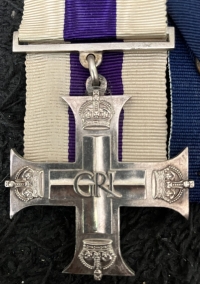


An Important
8th Army,
(The Desert Rats)
“Operation Crusader, Prisoner of War”
MILITARY CROSS (1942)
(With Battle Citation)
113197, Lieutenant MAURICE B. PAYNE. R.H.A.
102 Light Anti Aircraft & Anti Tank Regiment. R.H.A.
*4th Armoured Brigade, (The Black Desert Rats)
7th Armoured Division……30 Corps.
(Post-War)
49th Anti-Tank Regiment, Royal Artillery.
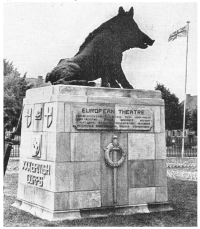 *The 4th Armoured Brigade saw service in the North African Campaign, the Allied invasion of Sicily, the Italian Campaign and in North-western Europe. Although it served under many different formations it was most famous as part of the 7th Armoured Division, the "Desert Rats".
Lt Payne was later a Prisoner of War in Italy & Germany.
*The 4th Armoured Brigade saw service in the North African Campaign, the Allied invasion of Sicily, the Italian Campaign and in North-western Europe. Although it served under many different formations it was most famous as part of the 7th Armoured Division, the "Desert Rats".
Lt Payne was later a Prisoner of War in Italy & Germany.
 [THE MEDALS]
Military Cross. (1942) Unnamed as issued
[THE MEDALS]
Military Cross. (1942) Unnamed as issued
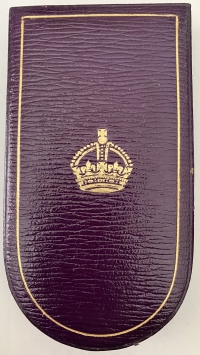 In “mint” original Royal Mint case of issue.
London Gazette. 20th January 1942.
1939-1945 Star
Africa Star (8th Army Clasp)
Defence Medal
War Medal 1939-1945
[THE CITATION] London Gazette, 20th January 1942
“ Lt Payne’s troop was escort to L/N Bty RHA on 20 November in the area of BIR EL GRASA (4737) where they were isolated from the rest of the Bde. Here they were attacked several times by tanks and lorried infantry, all of which were repulsed with heavy losses. Amongst the damage inflicted by Lt Payne’s troops were four Mk IV tanks destroyed at ranges from 400 to 700 yards. Throughout the period Lt Payne showed exceptional courage and determination, and handled his guns with skill and resolution in spite of the heavy gunfire and small arms fire directed at his position”
[MAURICE BERNARD PAYNE, 1912-1948] Age 36.
From Walton-on-Thames, Surrey.
[PRISONER OF WAR]
Campo 35, Naples, Italy (c, December 1941 to December 1943)
Lt Payne was reported as missing on 22nd November 1941 two days after his Military Cross action at Bir el Grasa. Six months later in April 1942 he was confirmed as WOUNDED and being held as a Prisoner of War in ITALY at “PG35” the converted Padula Monastery near Naples. The camp opened for prisoners on 22nd March 1942.
In “mint” original Royal Mint case of issue.
London Gazette. 20th January 1942.
1939-1945 Star
Africa Star (8th Army Clasp)
Defence Medal
War Medal 1939-1945
[THE CITATION] London Gazette, 20th January 1942
“ Lt Payne’s troop was escort to L/N Bty RHA on 20 November in the area of BIR EL GRASA (4737) where they were isolated from the rest of the Bde. Here they were attacked several times by tanks and lorried infantry, all of which were repulsed with heavy losses. Amongst the damage inflicted by Lt Payne’s troops were four Mk IV tanks destroyed at ranges from 400 to 700 yards. Throughout the period Lt Payne showed exceptional courage and determination, and handled his guns with skill and resolution in spite of the heavy gunfire and small arms fire directed at his position”
[MAURICE BERNARD PAYNE, 1912-1948] Age 36.
From Walton-on-Thames, Surrey.
[PRISONER OF WAR]
Campo 35, Naples, Italy (c, December 1941 to December 1943)
Lt Payne was reported as missing on 22nd November 1941 two days after his Military Cross action at Bir el Grasa. Six months later in April 1942 he was confirmed as WOUNDED and being held as a Prisoner of War in ITALY at “PG35” the converted Padula Monastery near Naples. The camp opened for prisoners on 22nd March 1942.
 “The large medieval monastery building at Padula, is in a beautiful valley south-east of Salerno in southern Italy. It was probably the most beautiful P.O.W. camp in Europe set in a fruitful shining valley surrounded by mountains… It is a very large building with honey coloured walls and of old and lichened tiles, built on a grid-iron plan in honour of its patron saint, St Lawrence.
Today, the monastery is a World Heritage Site open to the public all year.
It was converted into accommodation for officer prisoners, the first batch of whom went into residence on 22 March 1942.
A high-ceilinged monks' refectory became the officers' mess and served also for entertainments, and there was a two-acre area in grass to provide a playing field, walking space and gardens.
After a preliminary period of food shortage, it was soon found that some members of the camp staff were willing to act as middle-men for the purchase of black-market goods.
By May, hams, poultry, cheese, eggs and large amounts of condensed milk were being smuggled into the mess, to say nothing of private transactions. So that with the Red Cross food parcels which had arrived towards the end of April, the late spring became a period of plenty. Clothing could be ordered from a visiting tailor. The camp soon had a well-stocked library and the lectures and classes common to most camps. There was no difficulty in providing talent for a variety of good entertainment from the 400-odd officers and 140-odd other ranks to which the camp strength had risen by the middle of the year.
Lt Payne was later transferred to captivity in GERMANY at Oflag 79 at BRAUNSCHWEIG.
“The large medieval monastery building at Padula, is in a beautiful valley south-east of Salerno in southern Italy. It was probably the most beautiful P.O.W. camp in Europe set in a fruitful shining valley surrounded by mountains… It is a very large building with honey coloured walls and of old and lichened tiles, built on a grid-iron plan in honour of its patron saint, St Lawrence.
Today, the monastery is a World Heritage Site open to the public all year.
It was converted into accommodation for officer prisoners, the first batch of whom went into residence on 22 March 1942.
A high-ceilinged monks' refectory became the officers' mess and served also for entertainments, and there was a two-acre area in grass to provide a playing field, walking space and gardens.
After a preliminary period of food shortage, it was soon found that some members of the camp staff were willing to act as middle-men for the purchase of black-market goods.
By May, hams, poultry, cheese, eggs and large amounts of condensed milk were being smuggled into the mess, to say nothing of private transactions. So that with the Red Cross food parcels which had arrived towards the end of April, the late spring became a period of plenty. Clothing could be ordered from a visiting tailor. The camp soon had a well-stocked library and the lectures and classes common to most camps. There was no difficulty in providing talent for a variety of good entertainment from the 400-odd officers and 140-odd other ranks to which the camp strength had risen by the middle of the year.
Lt Payne was later transferred to captivity in GERMANY at Oflag 79 at BRAUNSCHWEIG.
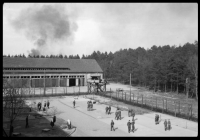 Offizierslager 79
( “Officers’ Camp 79" ) [Dec’ 43- May 45].
This officers’ camp was established at BRAUNSCHWEIG, Germany in December 1943 with men like Lt Payne being transferred from the camps in Italy. These were mainly British Commonwealth officers captured in Crete and those taken during North African Campaigns. More prisoners arrived in July 1944 having been transferred from OFLAG VIII-G.
On 24 August 1944 the camp was strafed by American & British aircraft. Three men were killed, and 14 seriously wounded.
The camp was liberated by the U.S. Ninth Army on 12th April 1945.
[ITEMS ALSO INCLUDED]
Offizierslager 79
( “Officers’ Camp 79" ) [Dec’ 43- May 45].
This officers’ camp was established at BRAUNSCHWEIG, Germany in December 1943 with men like Lt Payne being transferred from the camps in Italy. These were mainly British Commonwealth officers captured in Crete and those taken during North African Campaigns. More prisoners arrived in July 1944 having been transferred from OFLAG VIII-G.
On 24 August 1944 the camp was strafed by American & British aircraft. Three men were killed, and 14 seriously wounded.
The camp was liberated by the U.S. Ninth Army on 12th April 1945.
[ITEMS ALSO INCLUDED]
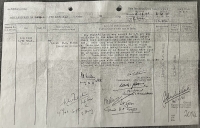 1). A photocopy of the original and detailed description of the action and recommendation for the award, which formed the citation. Army Form 2131. Signed by General Auchinleck.
1). A photocopy of the original and detailed description of the action and recommendation for the award, which formed the citation. Army Form 2131. Signed by General Auchinleck.
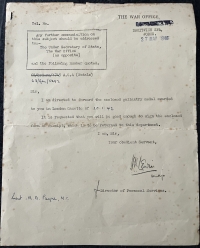 2).The original War Office issue of award letter, dated 27th May 1946 which indicates that the Military Cross wasn’t sent to
Lt Payne until a year after the war’s end.
2).The original War Office issue of award letter, dated 27th May 1946 which indicates that the Military Cross wasn’t sent to
Lt Payne until a year after the war’s end.
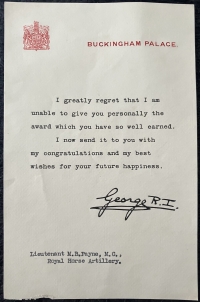 3). The Original Buckingham Palace Letter named to Lt, M.B. Payne from
King George VI in which he apologises for his inability to personally present the MC.
4).Also, a newspaper article about the tragic & fatal accident that befell Major Payne when he fell off a cliff at Haverfordwest.
WESTERN MAIL, Cardiff, 29th July 1948
” Major's Fatal fall from Cliff Face at Haverfordwest"
A verdict of: “Death from a fracture of the skull accidentally sustained through falling from the cliff face” was returned at the Haverfordwest inquest yesterday on Major Maurice Bernard Payne, age 36, of 49th Anti-Tank Regiment, Royal Artillery,
Horton Barracks, Worcester.
On temporary detachment at Merrion Camp, Pembroke.
His home address was 31 Winchester road Walton-on-Thames, Surrey.
Lieut Neil Calvert said that Major Payne and he set out for a walk along the coast to Bosheston on Saturday evening.
They had walked about three-quarters of a mile when when they could proceed no further. Each attempted to climb the steep slope up the cliff, one on either side of the bay. Witness came across crumbling rock and decided not to try any further.
“ON LEDGE"
Major Payne was on a grassy ledge about 30ft up.
The Major said that he did not think he was able to get up or down. He was not at all concerned and was rather laughing about it. Witness tried to climb up to help him down. In the meantime Major Payne said he would have another try at reaching the top.
There was a fall of a few bits of stone and rock, and he shouted to the Major to be careful. The next thing he realised was the Major falling down to the rocks. He found him unconscious and rushed for assistance.
Dr Clifford Newman house surgeon at the County Hospital, said that Major Payne died the following morning, death being due the laceration of the brain consequent upon a fracture of the skull.
A very tragic & extremely sad end to the life of a first class and decorated soldier who had survived a wounding in the desert war against Rommel and had endured the privations of life during three and a half years of captivity as a Prisoner of War in Italy & Germany.
3). The Original Buckingham Palace Letter named to Lt, M.B. Payne from
King George VI in which he apologises for his inability to personally present the MC.
4).Also, a newspaper article about the tragic & fatal accident that befell Major Payne when he fell off a cliff at Haverfordwest.
WESTERN MAIL, Cardiff, 29th July 1948
” Major's Fatal fall from Cliff Face at Haverfordwest"
A verdict of: “Death from a fracture of the skull accidentally sustained through falling from the cliff face” was returned at the Haverfordwest inquest yesterday on Major Maurice Bernard Payne, age 36, of 49th Anti-Tank Regiment, Royal Artillery,
Horton Barracks, Worcester.
On temporary detachment at Merrion Camp, Pembroke.
His home address was 31 Winchester road Walton-on-Thames, Surrey.
Lieut Neil Calvert said that Major Payne and he set out for a walk along the coast to Bosheston on Saturday evening.
They had walked about three-quarters of a mile when when they could proceed no further. Each attempted to climb the steep slope up the cliff, one on either side of the bay. Witness came across crumbling rock and decided not to try any further.
“ON LEDGE"
Major Payne was on a grassy ledge about 30ft up.
The Major said that he did not think he was able to get up or down. He was not at all concerned and was rather laughing about it. Witness tried to climb up to help him down. In the meantime Major Payne said he would have another try at reaching the top.
There was a fall of a few bits of stone and rock, and he shouted to the Major to be careful. The next thing he realised was the Major falling down to the rocks. He found him unconscious and rushed for assistance.
Dr Clifford Newman house surgeon at the County Hospital, said that Major Payne died the following morning, death being due the laceration of the brain consequent upon a fracture of the skull.
A very tragic & extremely sad end to the life of a first class and decorated soldier who had survived a wounding in the desert war against Rommel and had endured the privations of life during three and a half years of captivity as a Prisoner of War in Italy & Germany.
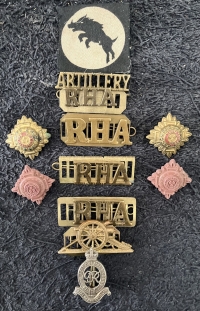

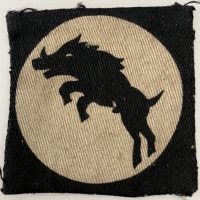
 A really excellent, seldom seen & interesting 8th Army (Desert Rats) Gallantry group of five with an original 30 Corps “wild boar” arm patch (left sleeve) and several other various brass RHA collar dogs & titles etc.
£2,995.00
A really excellent, seldom seen & interesting 8th Army (Desert Rats) Gallantry group of five with an original 30 Corps “wild boar” arm patch (left sleeve) and several other various brass RHA collar dogs & titles etc.
£2,995.00
 *The 4th Armoured Brigade saw service in the North African Campaign, the Allied invasion of Sicily, the Italian Campaign and in North-western Europe. Although it served under many different formations it was most famous as part of the 7th Armoured Division, the "Desert Rats".
Lt Payne was later a Prisoner of War in Italy & Germany.
*The 4th Armoured Brigade saw service in the North African Campaign, the Allied invasion of Sicily, the Italian Campaign and in North-western Europe. Although it served under many different formations it was most famous as part of the 7th Armoured Division, the "Desert Rats".
Lt Payne was later a Prisoner of War in Italy & Germany.
 [THE MEDALS]
Military Cross. (1942) Unnamed as issued
[THE MEDALS]
Military Cross. (1942) Unnamed as issued
 In “mint” original Royal Mint case of issue.
London Gazette. 20th January 1942.
1939-1945 Star
Africa Star (8th Army Clasp)
Defence Medal
War Medal 1939-1945
[THE CITATION] London Gazette, 20th January 1942
“ Lt Payne’s troop was escort to L/N Bty RHA on 20 November in the area of BIR EL GRASA (4737) where they were isolated from the rest of the Bde. Here they were attacked several times by tanks and lorried infantry, all of which were repulsed with heavy losses. Amongst the damage inflicted by Lt Payne’s troops were four Mk IV tanks destroyed at ranges from 400 to 700 yards. Throughout the period Lt Payne showed exceptional courage and determination, and handled his guns with skill and resolution in spite of the heavy gunfire and small arms fire directed at his position”
[MAURICE BERNARD PAYNE, 1912-1948] Age 36.
From Walton-on-Thames, Surrey.
[PRISONER OF WAR]
Campo 35, Naples, Italy (c, December 1941 to December 1943)
Lt Payne was reported as missing on 22nd November 1941 two days after his Military Cross action at Bir el Grasa. Six months later in April 1942 he was confirmed as WOUNDED and being held as a Prisoner of War in ITALY at “PG35” the converted Padula Monastery near Naples. The camp opened for prisoners on 22nd March 1942.
In “mint” original Royal Mint case of issue.
London Gazette. 20th January 1942.
1939-1945 Star
Africa Star (8th Army Clasp)
Defence Medal
War Medal 1939-1945
[THE CITATION] London Gazette, 20th January 1942
“ Lt Payne’s troop was escort to L/N Bty RHA on 20 November in the area of BIR EL GRASA (4737) where they were isolated from the rest of the Bde. Here they were attacked several times by tanks and lorried infantry, all of which were repulsed with heavy losses. Amongst the damage inflicted by Lt Payne’s troops were four Mk IV tanks destroyed at ranges from 400 to 700 yards. Throughout the period Lt Payne showed exceptional courage and determination, and handled his guns with skill and resolution in spite of the heavy gunfire and small arms fire directed at his position”
[MAURICE BERNARD PAYNE, 1912-1948] Age 36.
From Walton-on-Thames, Surrey.
[PRISONER OF WAR]
Campo 35, Naples, Italy (c, December 1941 to December 1943)
Lt Payne was reported as missing on 22nd November 1941 two days after his Military Cross action at Bir el Grasa. Six months later in April 1942 he was confirmed as WOUNDED and being held as a Prisoner of War in ITALY at “PG35” the converted Padula Monastery near Naples. The camp opened for prisoners on 22nd March 1942.
 “The large medieval monastery building at Padula, is in a beautiful valley south-east of Salerno in southern Italy. It was probably the most beautiful P.O.W. camp in Europe set in a fruitful shining valley surrounded by mountains… It is a very large building with honey coloured walls and of old and lichened tiles, built on a grid-iron plan in honour of its patron saint, St Lawrence.
Today, the monastery is a World Heritage Site open to the public all year.
It was converted into accommodation for officer prisoners, the first batch of whom went into residence on 22 March 1942.
A high-ceilinged monks' refectory became the officers' mess and served also for entertainments, and there was a two-acre area in grass to provide a playing field, walking space and gardens.
After a preliminary period of food shortage, it was soon found that some members of the camp staff were willing to act as middle-men for the purchase of black-market goods.
By May, hams, poultry, cheese, eggs and large amounts of condensed milk were being smuggled into the mess, to say nothing of private transactions. So that with the Red Cross food parcels which had arrived towards the end of April, the late spring became a period of plenty. Clothing could be ordered from a visiting tailor. The camp soon had a well-stocked library and the lectures and classes common to most camps. There was no difficulty in providing talent for a variety of good entertainment from the 400-odd officers and 140-odd other ranks to which the camp strength had risen by the middle of the year.
Lt Payne was later transferred to captivity in GERMANY at Oflag 79 at BRAUNSCHWEIG.
“The large medieval monastery building at Padula, is in a beautiful valley south-east of Salerno in southern Italy. It was probably the most beautiful P.O.W. camp in Europe set in a fruitful shining valley surrounded by mountains… It is a very large building with honey coloured walls and of old and lichened tiles, built on a grid-iron plan in honour of its patron saint, St Lawrence.
Today, the monastery is a World Heritage Site open to the public all year.
It was converted into accommodation for officer prisoners, the first batch of whom went into residence on 22 March 1942.
A high-ceilinged monks' refectory became the officers' mess and served also for entertainments, and there was a two-acre area in grass to provide a playing field, walking space and gardens.
After a preliminary period of food shortage, it was soon found that some members of the camp staff were willing to act as middle-men for the purchase of black-market goods.
By May, hams, poultry, cheese, eggs and large amounts of condensed milk were being smuggled into the mess, to say nothing of private transactions. So that with the Red Cross food parcels which had arrived towards the end of April, the late spring became a period of plenty. Clothing could be ordered from a visiting tailor. The camp soon had a well-stocked library and the lectures and classes common to most camps. There was no difficulty in providing talent for a variety of good entertainment from the 400-odd officers and 140-odd other ranks to which the camp strength had risen by the middle of the year.
Lt Payne was later transferred to captivity in GERMANY at Oflag 79 at BRAUNSCHWEIG.
 Offizierslager 79
( “Officers’ Camp 79" ) [Dec’ 43- May 45].
This officers’ camp was established at BRAUNSCHWEIG, Germany in December 1943 with men like Lt Payne being transferred from the camps in Italy. These were mainly British Commonwealth officers captured in Crete and those taken during North African Campaigns. More prisoners arrived in July 1944 having been transferred from OFLAG VIII-G.
On 24 August 1944 the camp was strafed by American & British aircraft. Three men were killed, and 14 seriously wounded.
The camp was liberated by the U.S. Ninth Army on 12th April 1945.
[ITEMS ALSO INCLUDED]
Offizierslager 79
( “Officers’ Camp 79" ) [Dec’ 43- May 45].
This officers’ camp was established at BRAUNSCHWEIG, Germany in December 1943 with men like Lt Payne being transferred from the camps in Italy. These were mainly British Commonwealth officers captured in Crete and those taken during North African Campaigns. More prisoners arrived in July 1944 having been transferred from OFLAG VIII-G.
On 24 August 1944 the camp was strafed by American & British aircraft. Three men were killed, and 14 seriously wounded.
The camp was liberated by the U.S. Ninth Army on 12th April 1945.
[ITEMS ALSO INCLUDED]
 1). A photocopy of the original and detailed description of the action and recommendation for the award, which formed the citation. Army Form 2131. Signed by General Auchinleck.
1). A photocopy of the original and detailed description of the action and recommendation for the award, which formed the citation. Army Form 2131. Signed by General Auchinleck.
 2).The original War Office issue of award letter, dated 27th May 1946 which indicates that the Military Cross wasn’t sent to
Lt Payne until a year after the war’s end.
2).The original War Office issue of award letter, dated 27th May 1946 which indicates that the Military Cross wasn’t sent to
Lt Payne until a year after the war’s end.
 3). The Original Buckingham Palace Letter named to Lt, M.B. Payne from
King George VI in which he apologises for his inability to personally present the MC.
4).Also, a newspaper article about the tragic & fatal accident that befell Major Payne when he fell off a cliff at Haverfordwest.
WESTERN MAIL, Cardiff, 29th July 1948
” Major's Fatal fall from Cliff Face at Haverfordwest"
A verdict of: “Death from a fracture of the skull accidentally sustained through falling from the cliff face” was returned at the Haverfordwest inquest yesterday on Major Maurice Bernard Payne, age 36, of 49th Anti-Tank Regiment, Royal Artillery,
Horton Barracks, Worcester.
On temporary detachment at Merrion Camp, Pembroke.
His home address was 31 Winchester road Walton-on-Thames, Surrey.
Lieut Neil Calvert said that Major Payne and he set out for a walk along the coast to Bosheston on Saturday evening.
They had walked about three-quarters of a mile when when they could proceed no further. Each attempted to climb the steep slope up the cliff, one on either side of the bay. Witness came across crumbling rock and decided not to try any further.
“ON LEDGE"
Major Payne was on a grassy ledge about 30ft up.
The Major said that he did not think he was able to get up or down. He was not at all concerned and was rather laughing about it. Witness tried to climb up to help him down. In the meantime Major Payne said he would have another try at reaching the top.
There was a fall of a few bits of stone and rock, and he shouted to the Major to be careful. The next thing he realised was the Major falling down to the rocks. He found him unconscious and rushed for assistance.
Dr Clifford Newman house surgeon at the County Hospital, said that Major Payne died the following morning, death being due the laceration of the brain consequent upon a fracture of the skull.
A very tragic & extremely sad end to the life of a first class and decorated soldier who had survived a wounding in the desert war against Rommel and had endured the privations of life during three and a half years of captivity as a Prisoner of War in Italy & Germany.
3). The Original Buckingham Palace Letter named to Lt, M.B. Payne from
King George VI in which he apologises for his inability to personally present the MC.
4).Also, a newspaper article about the tragic & fatal accident that befell Major Payne when he fell off a cliff at Haverfordwest.
WESTERN MAIL, Cardiff, 29th July 1948
” Major's Fatal fall from Cliff Face at Haverfordwest"
A verdict of: “Death from a fracture of the skull accidentally sustained through falling from the cliff face” was returned at the Haverfordwest inquest yesterday on Major Maurice Bernard Payne, age 36, of 49th Anti-Tank Regiment, Royal Artillery,
Horton Barracks, Worcester.
On temporary detachment at Merrion Camp, Pembroke.
His home address was 31 Winchester road Walton-on-Thames, Surrey.
Lieut Neil Calvert said that Major Payne and he set out for a walk along the coast to Bosheston on Saturday evening.
They had walked about three-quarters of a mile when when they could proceed no further. Each attempted to climb the steep slope up the cliff, one on either side of the bay. Witness came across crumbling rock and decided not to try any further.
“ON LEDGE"
Major Payne was on a grassy ledge about 30ft up.
The Major said that he did not think he was able to get up or down. He was not at all concerned and was rather laughing about it. Witness tried to climb up to help him down. In the meantime Major Payne said he would have another try at reaching the top.
There was a fall of a few bits of stone and rock, and he shouted to the Major to be careful. The next thing he realised was the Major falling down to the rocks. He found him unconscious and rushed for assistance.
Dr Clifford Newman house surgeon at the County Hospital, said that Major Payne died the following morning, death being due the laceration of the brain consequent upon a fracture of the skull.
A very tragic & extremely sad end to the life of a first class and decorated soldier who had survived a wounding in the desert war against Rommel and had endured the privations of life during three and a half years of captivity as a Prisoner of War in Italy & Germany.



 A really excellent, seldom seen & interesting 8th Army (Desert Rats) Gallantry group of five with an original 30 Corps “wild boar” arm patch (left sleeve) and several other various brass RHA collar dogs & titles etc.
£2,995.00
A really excellent, seldom seen & interesting 8th Army (Desert Rats) Gallantry group of five with an original 30 Corps “wild boar” arm patch (left sleeve) and several other various brass RHA collar dogs & titles etc.
£2,995.00